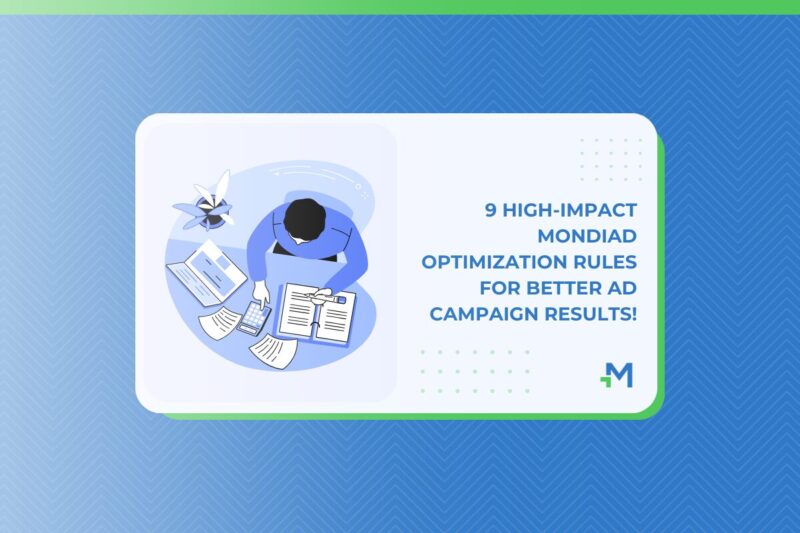As the digital advertising landscape and consumer behaviour continue to evolve at lightspeed, embracing ad campaign optimization rules will be crucial for advertisers, agencies and affiliates seeking to thrive in an increasingly competitive marketplace.
Why do we say this? Because optimization rules offer a strategic advantage by automatically fine-tuning campaigns in real-time, based on data-driven decision-making. From maximizing ROI to improving targeting assets, Mondiad smart optimization rules are a part of modern advertising tools, empowering marketers to harness the full potential of their campaigns.
Let our system do the work for you!
The Mondiad optimisation rules is an in-house technology for automated optimisations of your ad campaign, saving you time and money. They allow you to combine specific parameters to create rules around segments like creatives, subids, zoneids and campaigns.
The logic behind the optimization rules is very simple, namely, they are working via a model of if/then logical statements, or condition/action triggers. You set conditions based on specific performance metrics tailored to your campaign objective, then desired actions are triggered automatically when a specific condition or a group of conditions are met like:
- Increase bids to gain more traffic
- Decrease bids when overspending
- Pause underperforming segments
- …or a combination of these
Benefits:
- They save you time (and money) by allowing you to invest in more important tasks or deal with a higher work volume.
- They give you an extra feeling of safety and control since you set the rules.
- They eliminate human error.
- They protect your ad budget from overspending.
- They help you understand more quickly how your ad campaign is performing.
***
🔹 Disable low-performing segments consuming your budget.
Avoid spending your ad budget on ads that are not generating the results you’re looking for. Set a rule to pause your ads when they don’t bring you the expected results while spending your budget, or scale ads that perform well and don’t cost you too much.
– Disable low-converting ad creatives.
This one should be pretty straightforward. Let’s say you are testing multiple creatives and you are interested in knowing which ones convert, and which don’t. For this, let’s set up a rule that deactivates any bad creative, namely, any creative that gets over 5000 impressions, yet less than 10% ROI in the past day.
– Pause underperforming campaigns.
Similarly, we can pause a campaign altogether if, for example, we notice it gets shown, however, it is not converting. Let’s say that we create a rule where if a campaign gets more than 5000 clicks but less than 500 conversions during the past week, we want the system to automatically pause it. This way, we make sure we are not wasting resources and we can invest more tine in analysing its performance, and making optimizations for the better.
***
🔹 Scale up good segments.
Similarly to our previous example, you can also maximize your ROI by allocating more money to segments that are generating the best results.
– Increase the budget for campaigns that are performing well.
Let’s set a rule for increasing the campaign’s budget if it’s generating sales while not costing us more than the profit generated. For example, the bid will be increased by 0,001,% once every 6 hours if the campaign has generated more than 15% ROI during the last day while the spent did not exceed its optimal, desired level.
NOTE: bid increases/decreases can vary from 0.0001 to 5$.
– Increase bids on performing ZoneIDs.
For example, if a ZoneID has a CTR greater than 5%, with a minimum of 100 clicks in the last week, then the bids are easily increased every 6 houts, to buy more of that traffic.
***
🔹 Know your targets.
Let’s say you are dipping your toes in new territories and you want to find out your campaign’s best-targeting parameters. In this sense, we can also use the Mondiad optimisation rules to identify and add a ZoneId/SubId to an audience list that you want to target or you want to exclude by default when you create a new campaign.
– Save on costs by blacklisting low-performing ZoneID.
For example, let’s imagine you want to automatically exclude a ZoneID that spends over 10$ but generates less than 2 conversions. In this scenario will say that we want to also add these types of segments to an Audience, for later optimizations.
– Identify converting SubIDs for further optimizations.
For example, if a SubId is getting more than 100 clicks while spending under 50$ a day, then the SubId will be added to an audience list of good traffic.
***
🔹 Combine your rules!
– Divide your SubIDs by performance.
Don’t limit yourself to just one rule! If you have a clear understanding of your strategy, go for a combination of automated conditions at once. Take the following example, where we illustrate how you can divide your SubIDs based on their performance.
***
Best practices for creating optimization rules:
- Define your advertising strategy, goals and KPIs in advance. This will help you understand how to create the right rules.
- If your strategy allows it, you can use more than 1 rule per campaign, however, it is best to start small until you get a deeper understanding.
- Make your rules in such a way as to give you granular information about your campaign performance(based on SubIDs and ZoneIDs), and avoid wasting your budget.
- You can create and save your own Mondiad rules as templates as use them across other campaigns.
- Start with a test campaign in which you will identify the most profitable zones and filter them into an audience. Use that audience later in another campaign and make further optimizations.
- A rule will not necessarily be universally good for each campaign. Always consider the offer you are promoting, especially when switching niches, ad formats, geos and other high-impact campaign settings.
- The same idea applies when dealing with different ad formats and GEOs.
- Be mindful when setting up rule timeframes as they represent how often your rule will repeat itself.
- If a rule you created is not working as you desired, try testing different variants of it before deleting it.
***
Enough with the talk. It’s time for action. Come, let our smart optimization rules do the work for you, while you sit back and relax! Don’t believe us? Try for yourself!


















